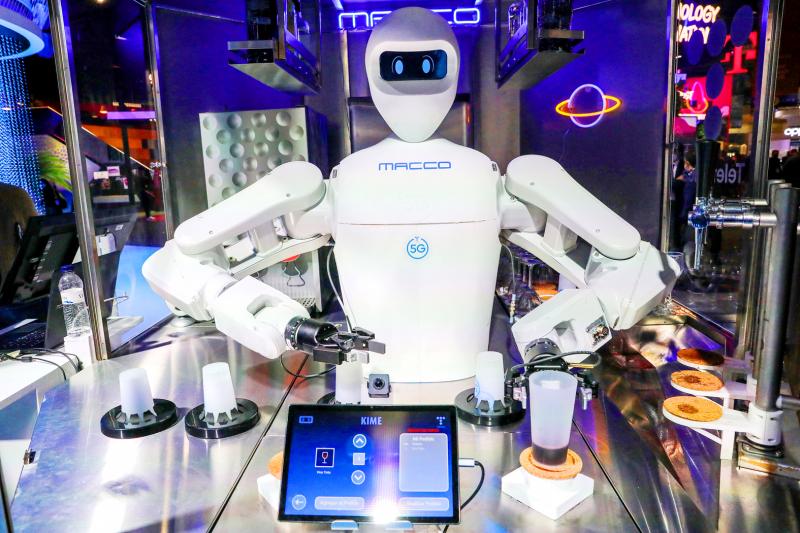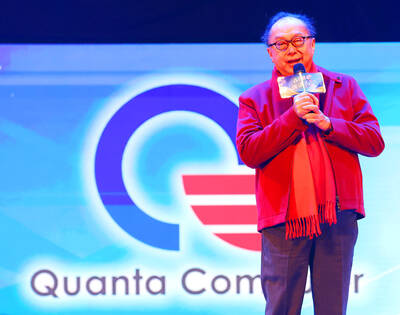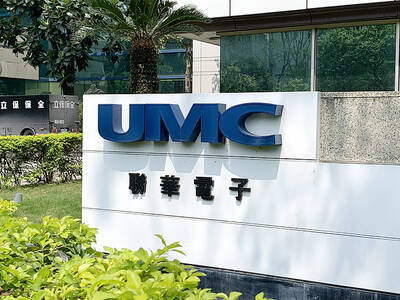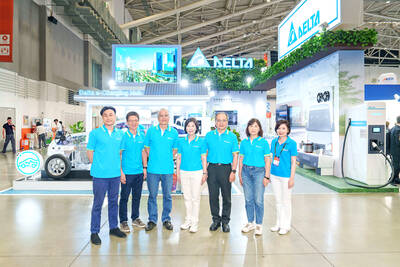One of the technology industry’s biggest annual get-togethers started in Barcelona, Spain, on Monday, under the shadow of Russia’s invasion of Ukraine.
The Mobile World Congress (MWC), where smartphone companies and telecoms show off their latest products and reveal their strategic visions, is expected to welcome more than 40,000 guests over its four-day run. Organizers were hoping to return to a full-scale event after two years of disruption caused by the COVID-19 pandemic, but they were forced to remove Russia’s dedicated pavilion following the invasion.
Opening the event, Mats Granryd of industry body GSMA said his organization “strongly condemns the Russian invasion of Ukraine,” drawing applause from the packed auditorium.

Photo: Bloomberg
However, some Russian companies were still participating in the event.
“We’re here as an independent company,” said Elizaveta Shulyndina at the stall of Kaspersky, a cybersecurity firm founded in Moscow, but with its holding company in the UK.
One of the few Ukrainian companies slated to display at the event told reporters that they would not be attending.
“We are staying in Ukraine and fighting for our country,” said Daria Fedko of WeAR Studio.
The invasion has sparked wider jitters, with the industry assessing likely shortages of key raw materials caused by the conflict, as well as sanctions slapped on Russia by the US, Europe and individual countries.
The MWC was canceled at the last minute in 2020 as the pandemic spread from China to Europe, and last year’s edition was drastically scaled down.
The pandemic continues to cast its shadow, with big names like Sony Group Corp, Asustek Computer Inc (華碩) and Lenovo Group Ltd (聯想) pulling out or participating virtually.
However, organizers are bullish, saying that 95 percent of speakers would be in Barcelona.
Smartphone behemoth Samsung Electronics Co, as well as Nokia Oyj, Ericsson AB, Alphabet Inc’s Google, Huawei Technologies Co (華為) and Verizon Communications Inc were all hosting major stalls.
Focuses of this year’s event include the rise of 5G, the opportunities offered by the Internet of Things (IoT), the metaverse and the impact of tech on the environment.
Thousands joined lines early in the morning to get into the event, but attendance is still much smaller than pre-pandemic levels, when the gathering welcomed more than 100,000 people.
However, the show would provide Chinese phone makers, such as Xiaomi Corp (小米), Oppo Mobile Telecommunications Corp (歐珀) and Vivo Communication Technology Co (維沃), with a “coming out party,” Ben Wood of CCS Insight said.
“It’s the first time they will be able to flex their muscles at a big Western trade show,” he told reporters, saying that they have all become much bigger during the pandemic.
They are filling a void left by Huawei, which has been hobbled by sanctions imposed by the US in 2019 over accusations that its wireless systems could allow spying by Chinese state entities.
The entire industry would now need to reckon with sanctions over the Ukraine invasion, with the US already announcing restrictions on technology exports to Russia.
Ukraine and Russia supply raw materials, such as neon and palladium, used to manufacture smartphone components.
Analysts say that the conflict could lead to shortages of many other products and rising prices, which could in turn hit demand for phones.
Vodafone Group chief executive officer Nick Read told the audience that the Ukraine war added to “the world’s political, economic, social and environmental turmoil.”
“We are all going to have to dig very deep to help overcome these challenges. As an industry it is our obligation to do our part,” he said.
The smartphone market grew by 5.7 percent last year, with 1.35 billion devices sold worldwide, analyst firm International Data Corp said.
Samsung sold the most phones, followed by Apple and Oppo.

Quanta Computer Inc (廣達) chairman Barry Lam (林百里) is expected to share his views about the artificial intelligence (AI) industry’s prospects during his speech at the company’s 37th anniversary ceremony, as AI servers have become a new growth engine for the equipment manufacturing service provider. Lam’s speech is much anticipated, as Quanta has risen as one of the world’s major AI server suppliers. The company reported a 30 percent year-on-year growth in consolidated revenue to NT$1.41 trillion (US$43.35 billion) last year, thanks to fast-growing demand for servers, especially those with AI capabilities. The company told investors in November last year that

United Microelectronics Corp (UMC, 聯電) forecast that its wafer shipments this quarter would grow up to 7 percent sequentially and the factory utilization rate would rise to 75 percent, indicating that customers did not alter their ordering behavior due to the US President Donald Trump’s capricious US tariff policies. However, the uncertainty about US tariffs has weighed on the chipmaker’s business visibility for the second half of this year, UMC chief financial officer Liu Chi-tung (劉啟東) said at an online earnings conference yesterday. “Although the escalating trade tensions and global tariff policies have increased uncertainty in the semiconductor industry, we have not

Intel Corp has named Tasha Chuang (莊蓓瑜) to lead Intel Taiwan in a bid to reinforce relations between the company and its Taiwanese partners. The appointment of Chuang as general manager for Intel Taiwan takes effect on Thursday, the firm said in a statement yesterday. Chuang is to lead her team in Taiwan to pursue product development and sales growth in an effort to reinforce the company’s ties with its partners and clients, Intel said. Chuang was previously in charge of managing Intel’s ties with leading Taiwanese PC brand Asustek Computer Inc (華碩), which included helping Asustek strengthen its global businesses, the company

Power supply and electronic components maker Delta Electronics Inc (台達電) yesterday said it plans to ship its new 1 megawatt charging systems for electric trucks and buses in the first half of next year at the earliest. The new charging piles, which deliver up to 1 megawatt of charging power, are designed for heavy-duty electric vehicles, and support a maximum current of 1,500 amperes and output of 1,250 volts, Delta said in a news release. “If everything goes smoothly, we could begin shipping those new charging systems as early as in the first half of next year,” a company official said. The new